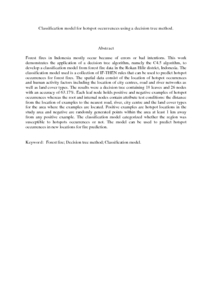Citation
Sitanggang, Imas Sukaesih and Ismail, Mohd Hasmadi
(2011)
Classification model for hotspot occurrences using a decision tree method.
Geomatics, Natural Hazards and Risk, 2 (2).
pp. 111-121.
ISSN 1947-5705; ESSN: 1947-5713
Abstract
Forest fires in Indonesia mostly occur because of errors or bad intentions. This work demonstrates the application of a decision tree algorithm, namely the C4.5 algorithm, to develop a classification model from forest fire data in the Rokan Hilir district, Indonesia. The classification model used is a collection of IF-THEN rules that can be used to predict hotspot occurrences for forest fires. The spatial data consist of the location of hotspot occurrences and human activity factors including the location of city centres, road and river networks as well as land cover types. The results were a decision tree containing 18 leaves and 26 nodes with an accuracy of 63.17%. Each leaf node holds positive and negative examples of hotspot occurrences whereas the root and internal nodes contain attribute test conditions: the distance from the location of examples to the nearest road, river, city centre and the land cover types for the area where the examples are located. Positive examples are hotspot locations in the study area and negative are randomly generated points within the area at least 1 km away from any positive example. The classification model categorized whether the region was susceptible to hotspots occurrences or not. The model can be used to predict hotspot occurrences in new locations for fire prediction.
Download File
![[img]](http://psasir.upm.edu.my/23879/1.hassmallThumbnailVersion/Classification%20model%20for%20hotspot%20occurrences%20using%20a%20decision%20tree%20method.pdf)  Preview |
|
PDF (Abstract)
Classification model for hotspot occurrences using a decision tree method.pdf
Download (85kB)
| Preview
|
|
Additional Metadata
Actions (login required)
 |
View Item |

